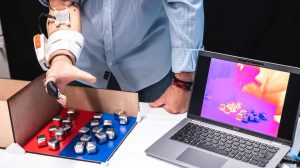A new device makes it possible for a person with an amputation to sense temperature with a prosthetic hand. The technology is a step toward prosthetic limbs that restore a full range of senses, improving both their usefulness and acceptance by those who wear them.
A team of researchers in Italy and Switzerland attached the device, called ”MiniTouch,” to the prosthetic hand of a 57-year-old man named Fabrizio, who has an above-the-wrist amputation. In tests, the man could identify cold, cool and hot bottles of liquid with perfect accuracy; tell the difference between plastic, glass and copper significantly better than chance; and sort steel blocks by temperature with around 75 percent accuracy, researchers report February 9 in Med.
“It’s important to incorporate these technologies in a way that prosthesis users can actually use to perform functional tasks,” says neuroengineer Luke Osborn of Johns Hopkins University Applied Physics Laboratory in Laurel, Md., who was not involved in the study. “Introducing new sensory feedback modalities could help give users more functionality they weren’t able to achieve before.”
The device also improved Fabrizio’s ability to tell whether he was touching an artificial or human arm. His accuracy was 80 percent with the device turned on, compared with 60 percent with it off. “It’s not quite as good as with the intact hand, probably because we’re not giving [information about] skin textures,” says neuroengineer Solaiman Shokur of EPFL, the Swiss Federal Institute of Technology in Lausanne.
Work to restore a sense of touch to prosthetic limbs has advanced greatly over the past decade (SN: 9/9/19). But the ability to detect temperature has lagged behind. “Temperature is almost the last modality that needs to be solved in order to then put all the results together and be able to make an artificial limb really feel as the biological one,” says EPFL engineer Jonathan Muheim.
The study builds on work the group published last May, which found that people who have had amputations often have spots on their residual limbs that, when heated or cooled, generate temperature sensations in their missing hand. It’s caused by stimulating nerves originally destined for the missing hand. The researchers showed they could reliably elicit phantom temperature sensations over time in 63 percent of amputees.
In the new study, Shokur, Muheim and colleagues first mapped Fabrizio’s phantom temperature sensations to match a spot on his arm to the corresponding sensation in the index finger of his missing hand. They then attached a temperature sensor to the fingertip of his prosthetic hand, which was connected via a controller unit to a device on Fabrizio’s arm that delivered appropriate temperature signals.
Currently the device employs only one sensor at the end of the index finger, but the team plans to add sensor-stimulator pairs to create more temperature-sensitive locations on the prosthetic hand. They are also planning to develop a prosthesis that combines the ability to sense touch as well as temperature. “In the coming year or so, hopefully that’s where we’ll be,” says Shokur.
The speed at which the device relays temperature may become an issue when combining multiple senses. Osborn and colleagues have developed a device as thin as a Band-Aid that delivers realistic cooling sensations nearly as quickly as natural responses, that team reported in Nature Biomedical Engineering last July.
In the immediate term, the new device needs to be tested in larger groups of participants, as well as real world settings, to ensure it isn’t adversely affected by high air temperatures or humidity. “We still need to do those crash tests outside the lab,” says Shokur.
Once it leaves the lab, Fabrizio already knows how he’d put it to use. “With these new technologies, I can understand better what I am touching,” Fabrizio said in a prerecorded video interview. “Certainly, my priority would be to use it in a kitchen to cook.”

